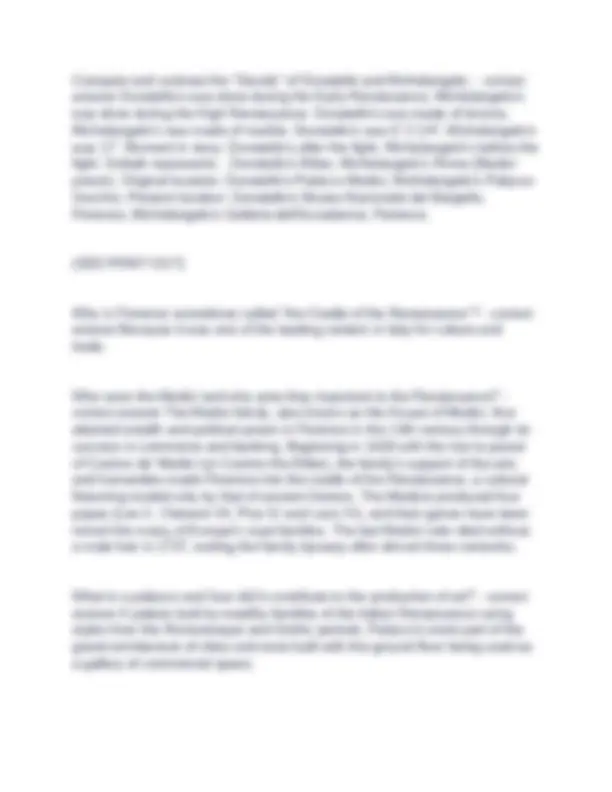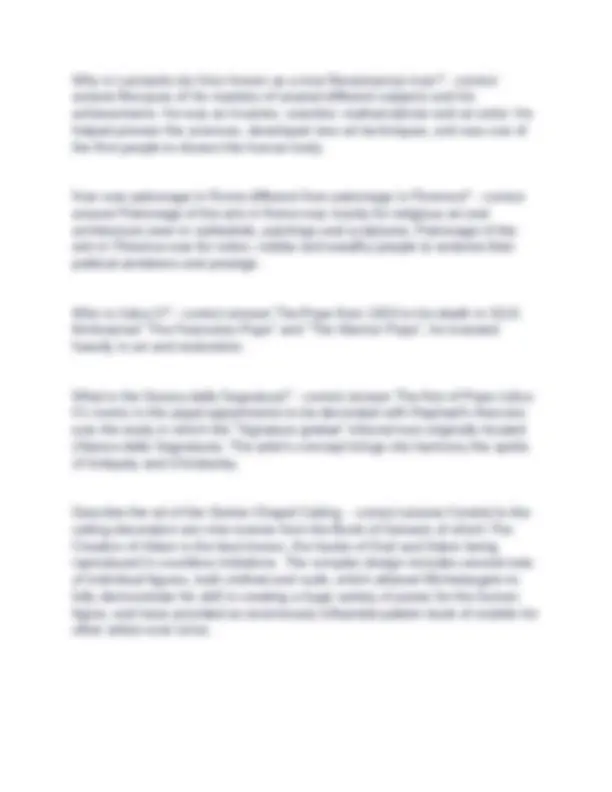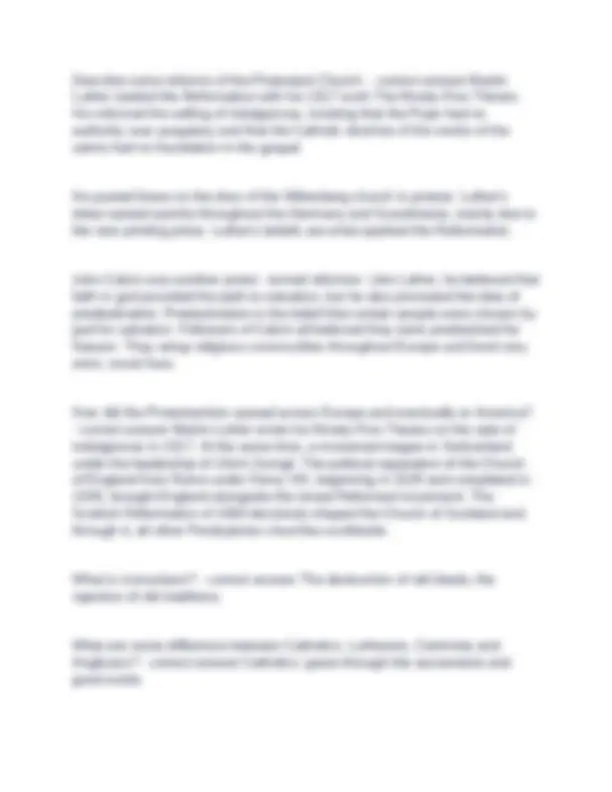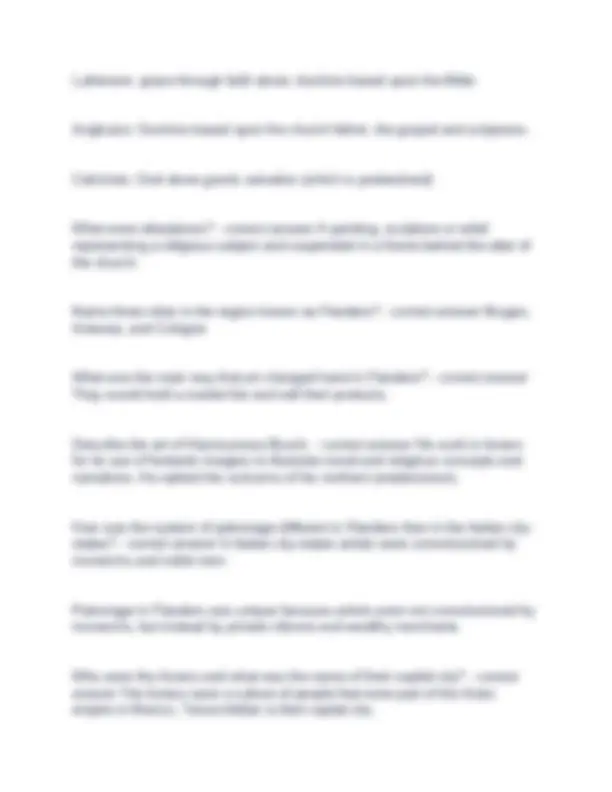











Study with the several resources on Docsity

Earn points by helping other students or get them with a premium plan


Prepare for your exams
Study with the several resources on Docsity

Earn points to download
Earn points by helping other students or get them with a premium plan
Community
Ask the community for help and clear up your study doubts
Discover the best universities in your country according to Docsity users
Free resources
Download our free guides on studying techniques, anxiety management strategies, and thesis advice from Docsity tutors
HUM 2235 Midterm review Questions with complete solution 2025
Typology: Exams
1 / 15

This page cannot be seen from the preview
Don't miss anything!










What time period is generally called the Renaissance? - correct answer 1400 - 1600 What is Humanism? - correct answer The recovery, study, and spread of the art and literature of Greece and Rome, and the application of their principles to education, politics, social life, and the arts in general. What is a guild? - correct answer The association of artisans or merchants or tradesmen who control the practice of their craft in a particular town. What is the concept of l'Uomo Universale? - correct answer L'Uomo Universale or the "Universal Person" is a term created by Leon Battista Alberti, a 15th century Florentine architect. A "Universal Person" was a man who developed his capabilities and talents to the fullest extent. The goal was to become a well-rounded person. Areas of skills included knowledge, physical development, social accomplishments, and the fine arts. Describe the ideal courtier according to Castigilione. - correct answer A man should take up arms and handling of weapons as his primary profession. He should be a bold, energetic, and faithful servant. He should strive to protect his reputation as such, for once his name is ever stained, it cannot be restored. Castiglione highly emphasizes education as essential for the ideal courtier, especially in the humanities. A man should also be able to speak Greek as well as Latin. He should be familiar with the writings of poets, orators, and historians, and able to produce his own poetry and prose. Castiglione claims the reward for these studies will be a bold self-confidence, but he cautions men to stay reserved and modest, not forward.
What did the term genius mean during the Renaissance? - correct answer This idea comes out of pagan animism and ancestor worship. The genius of a family, house, group, or state was the protecting, guiding, inspiring supernatural spirit which took care of it and was also the object of its worship. All good Romans therefore worshipped "the genius of Rome." "The genius of Rome" was the divine power protecting Rome, the Roman mission, Rome itself ("divine Rome"), and its heroic leaders and emperors. Godlike men were believed to receive from the gods a special destiny above that of ordinary mortals. These men became the Lares or genius for their time. Describe a Humanist education for men and women. - correct answer Humanistic education during the Renaissance reemphasized the Greek Ideal Mind, Body and Soul, stimulating the creative powers of the individual. Humanists (male) studied grammar, poetry, and history, as well as mathematics, astronomy, and music. Elementary schools educated middle- class children (male) while lower-class children (male) received little, if any, formal schooling. Children (male) of the nobility and upper classes attended humanist secondary schools. Educational opportunities for women improved slightly during the Renaissance, especially for the upper classes. Some girls from wealthy families attended schools of the royal court or received private lessons at home. The curriculum studied by young women was still based on the belief that only certain subjects, such as art, music, needlework, dancing, and poetry, were suited for females. For working-class girls, especially rural peasants, education was still limited to training in household duties such as cooking and sewing. Name some works by Michelangelo. - correct answer Bacchus, The God of Wine; The Pieta; David; The Bruges Madonna; Moses; The Florentine Pieta; The Sistine Chapel; The Creation of Adam; The Creation of Eve; The Great Flood
Why is Leonardo da Vinci known as a true Renaissance man? - correct answer Because of his mastery of several different subjects and his achievements. He was an inventor, scientist, mathematician and an artist. He helped pioneer the sciences, developed new art techniques, and was one of the first people to dissect the human body. How was patronage in Rome different from patronage in Florence? - correct answer Patronage of the arts in Rome was mostly for religious art and architecture seen in cathedrals, paintings and sculptures. Patronage of the arts in Florence was for rulers, nobles and wealthy people to endorse their political ambitions and prestige. Who is Julius II? - correct answer The Pope from 1503 to his death in 1513. Nicknamed "The Fearsome Pope" and "The Warrior Pope", he invested heavily in art and restoration. What is the Stanza della Segnatura? - correct answer The first of Pope Julius II's rooms in the papal appartments to be decorated with Raphael's frescoes was the study in which the "Signatura gratiae" tribunal was originally located (Stanza della Segnatura). The artist's concept brings into harmony the spirits of Antiquity and Christianity. Describe the art of the Sistine Chapel Ceiling. - correct answer Central to the ceiling decoration are nine scenes from the Book of Genesis of which The Creation of Adam is the best known, the hands of God and Adam being reproduced in countless imitations. The complex design includes several sets of individual figures, both clothed and nude, which allowed Michelangelo to fully demonstrate his skill in creating a huge variety of poses for the human figure, and have provided an enormously influential pattern book of models for other artists ever since.
What are sprezzatura, grazia and gravitas? - correct answer Sprezzatura is a deliberate nonchalance, the illusion that even the most difficult things are easy. Grazia is the elegance and beauty of movement or expression. Gravitas means high seriousness. Describe linear or scientific perspective. - correct answer A form of perspective in drawing and painting in which parallel lines are represented as converging so as to give the illusion of depth and distance. Who were Alhazen, Euclid, Ptoleny and Galen? How did they influence Brunelleschi? - correct answer They were mathematicians. Their understanding of the principles of geometry, and the sense of balance and proportion that geometry inspired, influenced every aspect of Brunelleschi's architectural work. Who was Marsilio Ficino? - correct answer He was an Italian scholar and Catholic priest who was one of the most influential humanist philosophers of the early Italian Renaissance. What is the subject of Botticelli's La Primavera? - correct answer The realm of Venus, sung by the ancient poets and by Poliziano (famous scholar at the court of the Medici). On the right Zephyrus (the blue faced young man) chases Flora and fecundates her with a breath. Flora turns into Spring, the elegant woman scattering her flowers over the world. Venus, in the middle, represents the "Humanitas" (the benevolence), which protects men. On the left the three Graces dance and Mercury dissipates the clouds. Describe some differences between Florence, Rome and Venice. - correct answer Florence: A self governed, independent state. City most associated
Describe the Art of Titian and Giorgione. - correct answer Fully utilized color and mood in their works. Executed both landscapes and portraits. Works done on canvas. Name some works by Leonardo da Vinci. - correct answer Mona Lisa; The Last Supper 1498; Vitruvian Man; St. John the Baptist; Fetus; Annunciation; Madonna of the Rocks Name the murals done by Raphael for the Papal rooms in the Vatican. - correct answer Cardinal Virtues Mount Parnassus Disputa School of Athens What does Vitruvian Man represent? - correct answer He represents the embodiment of health. He is also used more symbolically, as an image of science, art, and proportion enmeshed to embody the practice of medicine. What is tromp l'oeil? - correct answer visual illusion in art, especially as used to trick the eye into perceiving a painted detail as a three-dimensional object Where did the Protestant Reformation begin? - correct answer Germany Who was Martin Luther and what were his objections to Catholic Doctrine? - correct answer A German theologian who began the Protestant Reformation in the 16th Century. He objected to nepotism, simony, usury, pluralism and the sale of indulgences. He objected to paying up for your sins. He did away with confession, telling people they were saved by grace alone and not by sanctions such as confession of sins.
Describe some reforms of the Protestant Church. - correct answer Martin Luther started the Reformation with his 1517 work The Ninety-Five Theses. He criticized the selling of indulgences, insisting that the Pope had no authority over purgatory and that the Catholic doctrine of the merits of the saints had no foundation in the gospel. He posted these on the door of the Wittenberg church in protest. Luther's ideas spread quickly throughout the Germany and Scandinavia, mainly due to the new printing press. Luther's beliefs are what sparked the Reformation. John Calvin was another priest - turned reformer. Like Luther, he believed that faith in god provided the path to salvation, but he also promoted the idea of predestination. Predestination is the belief that certain people were chosen by god for salvation. Followers of Calvin all believed they were predestined for heaven. They setup religious communities throughout Europe and lived very strict, moral lives. How did the Protestantism spread across Europe and eventually to America?
Who were the Conquistadors and name two. - correct answer Soldiers and explorers from the Spanish Empire that explored the New World. Christopher Columbus and Hernan Cortes Describe Triangular Trade/The Atlantic Triangle & the Middle Passage. - correct answer Triangular Trade: trade in the 18th and 19th centuries that involved shipping goods from Britain to West Africa to be exchanged for slaves, these slaves being shipped to the West Indies and exchanged for sugar, rum, and other commodities, which were in turn shipped back to Britain. Atlantic Triangle: Slave trade which took place across the Atlantic Ocean from the 16th through 19th centuries. Middle Passage: The Middle Passage was the stage of the triangular trade in which millions of people from Africa were shipped to the New World as part of the Atlantic slave trade. Give some details about the Forbidden City. - correct answer It served as the home of emperors and their households as well as the ceremonial and political center of Chinese government for almost 500 years. The complex consists of 980 buildings covering 180 acres. What is Feng Shui? - correct answer a system of laws considered to govern spatial arrangement and orientation in relation to the flow of energy (qi), and whose favorable or unfavorable effects are taken into account when siting and designing buildings. What were the luxury arts? - correct answer Minor arts like gem-studded gold work, embellished armor, tapestries, and embroideries.
Describe the interaction between the Kongo and the Portuguese. - correct answer The Portuguese became allies of the Kongo king. The king made use of Portuguese teachers and craftsman to train his people. The Portuguese traded guns for slaves captured by the Kongo. Describe the Taj Mahal. - correct answer Also known as the Crown of Palaces, it is a white marble mausoleum located in Agra, Uttar Pradesh, India. What are some elements of Noh Theater. - correct answer Classical Japanese musical drama: all men performers, open theater, use of masks cover the actors faces. Who were the Inca? - correct answer The Inca Empire was the largest empire in pre-Columbian America. The administrative, political, and military center of the empire was located in Cusco in modern-day Peru. Inca was a civilization arose from the highlands of Peru sometime in the early 13th century, and the last Inca stronghold was conquered by the Spanish in 1572. What are assimilation and acculturation? - correct answer assimilation: the process of adapting or adjusting to the culture of a group or nation acculturation: the process of adopting the cultural traits or social patterns of another group. What was the Dissolution Act of 1536? - correct answer Also called the Dissolution of the Monasteries, it was the set of administrative and legal processes between 1536 and 1541 by which Henry VIII disbanded monasteries, priories, convents and friaries in England, Wales and Ireland, appropriated their income, disposed of their assets, and provided for their former members and functions.
Describe St. Mark's Cathedral. - correct answer A cathedral church of the Roman Catholic Archdiocese of Venice. It is the most famous of the city's churches and one of the best known examples of Italo-Byzantine architecture. For its opulent design, gold ground mosaics, and its status as a symbol of Venetian wealth and power, from the 11th century on the building has been known by the nickname Chiesa d'Oro (Church of gold). Why was Henry VIII considered a Renaissance Man? - correct answer Henry liked to think of himself as an intellectual. He believed that he had a quality mind and that he was a true Renaissance man. He surrounded himself with men of intellectual ability - men who could match his own ability. Who was Anne Boleyn? - correct answer Anne Boleyn was Queen of England from 1533 to 1536 as the second wife of King Henry VIII. Henry's marriage to Anne, and her subsequent execution, made her a key figure in the political and religious upheaval that was the start of the English Reformation. Who were Sir Francis Drake and Sir Walter Raleigh? - correct answer English knights who lived during the reign of Queen Elizabeth. There were send to American for tobacco leaves and to start plantations. What was Elizabeth I's relationship to the Arts? - correct answer Towards the end of her reign, England experienced a blossoming literary culture. Edward Spenser and William Shakespeare were both supported by the queen and likely drew inspiration from their regal leader. What is the difference between the form of a Petrarchan sonnet and an Elizabethan one? - correct answer The Petrarchan sonnet follows his structure and rhyme scheme.
Elizabethan sonnets, also known as Shakespearean or English sonnets, are structured differently and were first written by Elizabethan-era poets like William Shakespeare. What is a madrigal? - correct answer a part-song for several voices, especially one of the Renaissance period, typically arranged in elaborate counterpoint and without instrumental accompaniment. Describe Elizabethan drama. - correct answer The medieval religious drama written and acted in many towns throughout the country, and was a far less important feature in the life of London than of many other places. Elizabethan drama of the great period was altogether written in London and belonged distinctly to it. Why is Shakespeare so popular to this day? What is a soliloquy? What is an aside? How do they function in Shakespeare's plays? - correct answer Without doubt, Hamlet is one of the greatest dramatic characters ever created and is possibly the crowning achievement of Shakespeare's career. Shakespeare's skilful and psychologically-astute characterization is utterly remarkable because it was written hundreds of years before the concept of psychology was invented. A soliloquy is an act of speaking one's thoughts aloud when by oneself or regardless of any hearers, especially by a character in a play. An aside is a remark or passage by a character in a play that is intended to be heard by the audience but unheard by the other characters in the play.